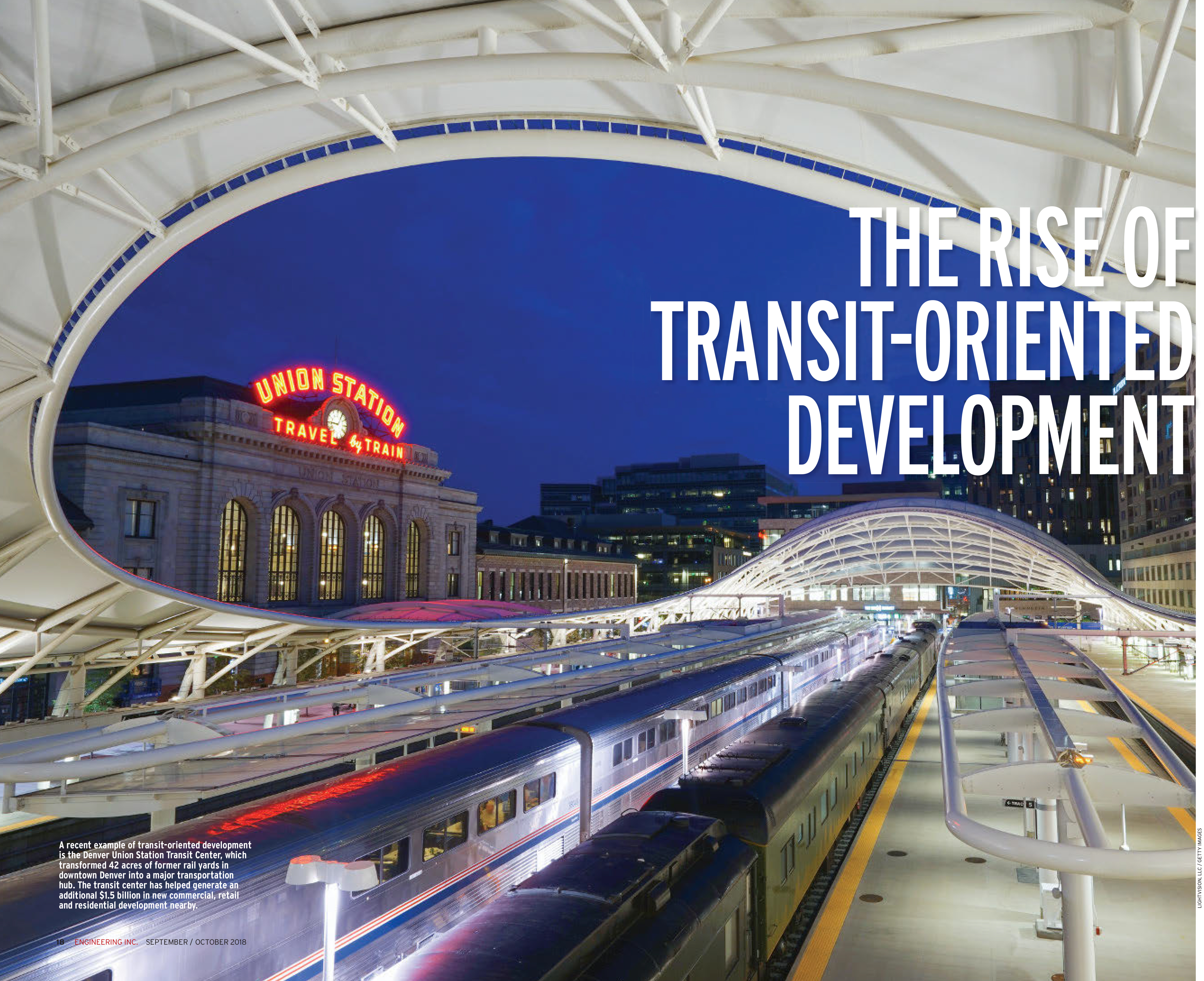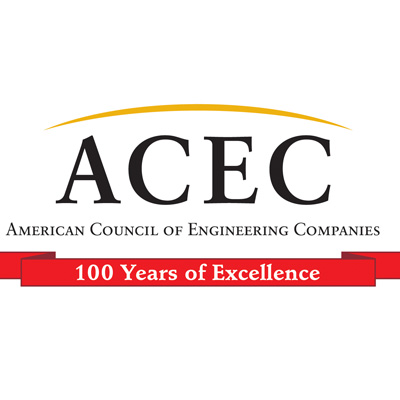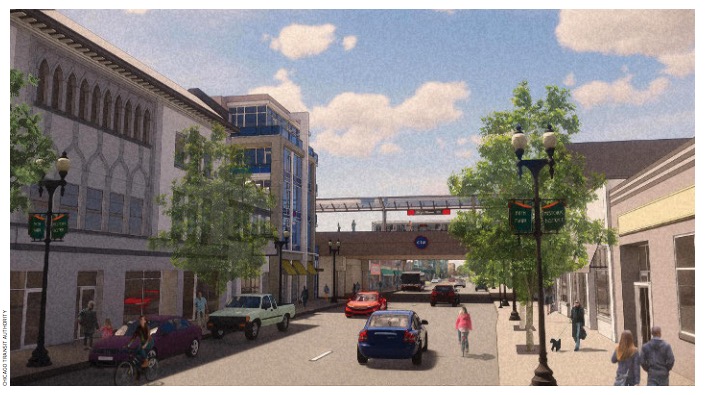AMERICAN COUNCIL OF ENGINEERING COMPANIES (ACEC)
 Transit-oriented development (TOD) is a fast-growing trend in creating vibrant, livable, sustainable communities. It involves the creation of compact, pedestrian-oriented, mixed-use communities centered around high-quality transit systems.
Transit-oriented development (TOD) is a fast-growing trend in creating vibrant, livable, sustainable communities. It involves the creation of compact, pedestrian-oriented, mixed-use communities centered around high-quality transit systems.
TOD represents a successful marriage of effective public planning combined with effective private development, and engineering firms are playing a key role in bringing the concept to life in several urban areas around the United States.
“TOD is taking off like a rocket, and how fast this is accelerating should be exciting news to the engineering world,” says Andy Kunz, president and CEO of the Transit Oriented Development Institute, which conducts conferences, provides educational resources and advocates for TOD best practices.
Metropolitan centers, such as Washington, D.C., and Denver, are much further along than others when it comes to TOD activity, according to Kunz. “Cities where the economy is struggling might not be seeing any signs of this yet, but this is the new model for real estate development,” Kunz says.
The concept of TOD has been around in various forms since the 1990s, and it reflects even earlier development cycles, Kunz says. “This is actually a revival of how we used to build cities prior to the age of car domination,” he says. “Now we have gone back to relearn how to make great urbanism, and we are still learning how to make great stations that are really walkable and integrated into the urbanism.”
Gaining Momentum
In recent years TOD has begun to pick up momentum, and a number of key factors have converged to help drive the growth of these developments across the country
“There has been a significant trend toward TOD in the last six years around the major metropolitan areas of the U.S.,” says Sean McLean, co-CEO of Renaissance Downtowns, a firm that works with local governments, community members and business leaders to reposition and revitalize neighborhoods with unmet demand for mixed-use, walkable developments.
“This trend definitely looks like it will continue as the country continues to urbanize,” says McLean. “We have been concentrating on large suburbs with direct transit access to New York City and Chicago.”
The market for sustainable mixed-use urbanized suburbs is helping to drive the growth, according to McLean. “The transit access is only an amenity, a way to be connected to others,” he says. “Typically, it is only looked at as rail, but increasingly bus and car services like Via, Uber and Lyft are making it easier to connect.”
Another factor driving growth is that many young people want to live in cities and are not interested in owning cars or sitting for hours a day stuck in traffic. “They want to ride trains or walk to work and not have to worry about having a car,” Kunz says. “That has had a huge effect on accelerating this trend.”
After years of potential drawbacks such as high real estate and rental costs, rising crime, poor schools and other factors, many cities have become desirable destinations again.
“There is a new urbanism movement,” says Kunz. “In the 1950s many people were leaving the cities and moving to the suburbs, and now we are seeing a shift back.”
At the same time, many suburban commuters have become weary of the constant traffic. While suburbia offers several possible benefits such as living space, lower crime and relative quiet, the quality of life can be reduced when residents must spend so much time getting to and from work in their vehicles.
A desire for greater community is another factor. “I believe that now and, in the future, as young people continue to be reliant on technology as a social platform, their human nature to want to be in a community will continue to drive them to denser mixed-use environments,” says McLean. “The transit access to a network of other dense, mixed-use environments ensures access to many different opportunities for social life and careers.”
In addition, many people have become more aware of the environmental impact of so much driving. High-occupancy vehicle lanes have been installed to try to reduce the number of vehicles on the roads, but traffic in major cities is still a major problem.
TOD is a possible way to address the serious and growing problems of climate change and global energy security by creating dense, walkable communities that greatly reduce the need for driving and energy consumption.
Given all these factors, it is no surprise that the TOD trend is gaining steam.
“In places like Washington, D.C., there are cranes everywhere and lots of mixed-use buildings,” says Kunz says. “Cities that have the most extensive rail systems are where TOD is growing fastest.”
A report by The George Washington University School of Business, “D.C.: The WalkUP Wake-Up Call,” illustrates the growth of the TOD trend. The report says walk-ups—walkable urban places—have accounted for 48 percent of income property (office, retail, apartment and hotel) in the metro D.C. area during the period from 2009 to the present. That compares with 34 percent in the period from 2001 to 2008 and 24 percent from 1992 to 2000.
Between 2010 and 2015, nearly 500 companies moved to or expanded in walkable downtown neighborhoods, according to Smart Growth America, an organization that promotes development that encourages a mix of building types and uses, diverse housing and transportation options, development within existing neighborhoods and community engagement.
The Role of Engineers
Engineers are playing a vital role in this development trend.
“TOD projects are being built in areas which were not designed for the capacity of the future, and the infrastructure that they do have is aging rapidly,” says McLean.
Engineers need to be increasingly creative in their approaches to marrying rapid growth to aging and often failing infrastructure issues. “It is important for the experts to educate governments on better ways to operate their municipalities,” McLean says. “Using big data and sustainable science must become the norm.”
In addition, engineers must continue to innovate with building technology that will help create cheaper, smart buildings. “They must help educate governments on new technology for sewer treatment, traffic analysis, and building products such as cross-laminate timber,” says McLean.
Bringing together major rail infrastructure and large stations with urbanism, buildings, utilities, etc. is an enormous engineering challenge.
“This is actually more challenging than building in the suburban sprawl model where everything is separated, spaced out,” says Kunz. “Basically, it is all the same engineering as anywhere else, except in TOD it is more like a city where everything is compact and tight together. That means all the engineering is more complicated.”
The projects involve building within tight spaces and relying on multi-use facilities.
“You are stacking residences on top of railways,” says Kunz. “The standard engineering is still the same, but the context is new, and the integration of everything is new.” TOD projects require rail engineers, building engineers, civil engineers and structural engineers—all working together to make the project a success.
One of the nation’s most ambitious TOD projects to date is Transit Oriented Denver, which was launched in 2006. Denver is taking a “systemwide approach to implement not just TOD but also transit communities for all of Denver’s residents,” according to the city’s website.
The TOD strategic plan provides a foundation to guide public and private investment at rail stations by creating an implementation action plan through research and analysis of the existing state of TOD; providing citywide, high-level policy recommendations and station-level action items with the intent to foster implementation of TOD at rail stations; and establishing a system to track and monitor Denver’s success so the city can continue to refine and improve its strategic moves in the future.
Since the launch of the program, the city has created long-range plans for 21 station areas; implemented a TOD typology through new “context-sensitive” zoning; established a TOD Fund to create and preserve affordable housing at station areas; and spent millions of dollars on infrastructure in TOD areas.
AECOM led the planning and design of the Denver Union Station Transit Center, which generated an additional $1.5 billion in new commercial, retail and residential development nearby.
The project transformed 42 acres of former rail yards into a centerpiece for downtown Denver, anchoring and facilitating connections between the region’s transit systems, according to Richard Romig, vice president, transportation at AECOM.
“Riders can now transition easily between bus and rail by way of an iconic, eight-track commuter rail train hall, a new light-rail station and a 22-bay underground bus concourse,” says Romig. Additional improvements, including street realignments and public plazas, set the stage for a mixed-use transformation.
As of its opening in 2014, the effort was considered the largest multimodal project in the U.S. and the largest multimodal project ever to earn Leadership in Energy and Environmental Design (LEED) Gold certification from the U.S. Green Building Council.
The original master plan placed all transportation modes underground, but the AECOM-led design team reimagined that plan by moving all rail functions up to street level, making the layout more conducive to private development. The move is estimated to have saved more than $100 million in underground construction costs.
“Once the concept was refined and permits were completed, our engineers worked quickly and diligently to develop phased design packages for construction,” says Romig. “A very high level of communication is required to facilitate complete designs that are fully coordinated and/or integrated.”
Another TOD project underway is the Manhattan West Platform in New York City. The platform is located over transit tracks and is the gateway to the increasingly popular Hudson Yards neighborhood. Mueser Rutledge Consulting Engineers (MRCE) is working on the project with real estate operating company Brookfield Properties.
“The platform set the stage for the development of Manhattan West complex,” says Henry Caso, senior vice president, Manhattan West Construction U.S. Office Division, at Brookfield Properties.
“The concept for utilizing post tensioned pre-cast concrete for the platform was developed by the engineers brainstorming on how Brookfield could unlock the site’s potential for high-rise construction,” says Caso. “Engineers were crucial to the design and construction of all facets of the platform.”
That includes protection of existing structures, safeguarding adjacent railroad right of way, safety for the environment created below the platform, design of custom-made equipment for construction of the platform, design of the platform to accommodate future development and flexibility to develop various schemes, monitoring the construction and developing the sequence of construction and designing the buildings to avoid disruption to the transit system below.
Brookfield continues to look for opportunities to develop over or near transit facilities and has hosted many other developers interested in the methods employed at Manhattan West to coexist with an existing transit system.
“I believe engineers will continue to create innovative techniques to fill in the areas of the urban landscape previously disregarded as potential development sites,” says Caso.
With respect to the transit aspect of Manhattan West, the engineering goal was simple: protect the transit and design foundations in a manner that accommodates both transit and high-rise building demands, according to David Good, partner at MRCE.
“When working in the most heavily trafficked rail yard in the country, every bit of foundation and support of excavation design required engineers to account for limited access, active train loads, potential train impacts and dynamic geometric constraints,” says Good.
On top of that—literally—is the deck over the rail yard that has a 220-foot open span below, leaving the tracks untouched.
“The massive pre-cast deck must be able to move laterally a small amount due to temperature changes, but up to several inches in a seismic event,” says Good. “That requirement presented its own challenges, not only for the deck foundations, but for the building foundations that must pass through the deck or abut it.”
MRCE is currently working on numerous TOD projects. “These projects are more common as developers have become interested in over-builds or sites immediately adjacent to transit lines,” says Good.
Specific to TOD, “engineers can play a vital role in actually planning the project, rather than just executing a completed design,” says Good. “TOD projects have special demands that may not be initially evident to project developers or architects. The key role for engineers is to elucidate those demands or restrictions early in the planning phase of the project. That allows early engineering design of optimal means to accommodate both development and transit demands.”
Looking ahead to the future, engineers and environmental scientists must help lead the way in TOD development. “There is a spider web of analysis which must be done to ensure the successful long-term health of the ecosystem of a dense, mixed-use development in an already developed area,” says McLean.
Chances are that if there is transit, then development happened before and after the transit was built. “Engineers must use all available tools to solve current and future traffic needs, sewer and water needs, ground and surface water protection, storm water management and coastal resiliency,” says McLean. “Choosing our engineering firm is one of the most important choices we make when starting a new project. The firms that demonstrate the most creativity and flexibility are the ones we go with.”
Firms will likely see an increase in TOD activity in the years ahead.
“You cannot have TOD without engineers,” says Romig. “Engineers are essential to the transportation project concept and planning, environmental permit clearance, design and construction of the transportation element of the development.”
TOD efforts must also be coordinated with the municipality and developer interests from inception to completion. “Once the construction of the transportation backbone is underway, you will see the adjacent development start to rise,” Romig says. “Engineers also engage in site and building design with the development team. It was and still is truly breathtaking to see at least 20 buildings rise in and around the Denver Union Station Transit Center in the last six years. It seems like there is a new building opening every month.”
Download full article (PDF): The Rise of Transit-Oriented Development
Download full September/October issue of Engineering, Inc.
 About the American Council of Engineering Companies
About the American Council of Engineering Companies
www.acec.org
The American Council of Engineering Companies (ACEC) is the voice of America’s engineering industry. Council members – numbering more than 5,000 firms representing more than 500,000 employees throughout the country – are engaged in a wide range of engineering works that propel the nation’s economy, and enhance and safeguard America’s quality of life. These works allow Americans to drink clean water, enjoy a healthy life, take advantage of new technologies, and travel safely and efficiently. The Council’s mission is to contribute to America’s prosperity and welfare by advancing the business interests of member firms.
Tags: ACEC, American Council of Engineering Companies, Engineering Inc., TOD, Transit-Oriented Development







 RSS Feed
RSS Feed
This is an interesting article but needs to be extended to realize that the new innovative transit technologies can be used to provide opportunities for much smaller, less dense and more widely distributed TODs – in addition the the large, dense developments featured in this article. An example is a transit concept, now under developement called Transit X http://www.transitx.com It is very well suited to provide opportunities for the development of smaller TODs in our many very dispersed cities in locations where the larger TOD’s are not viable. It’s regional scale networks can be easily extended to serve new urban growth as our cities continue to expand beyond their presently developed areas. AS is true in may cases, a large number of small developments are often much more effective and useful than a few large and often very congested ones.